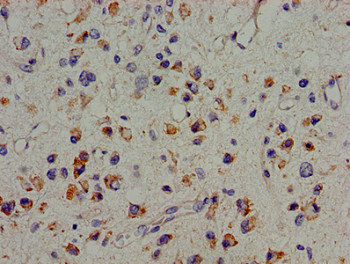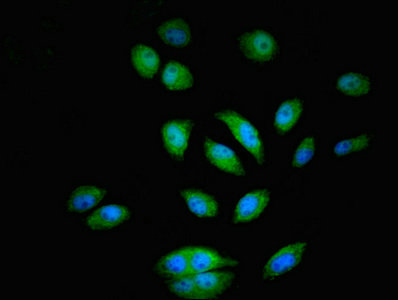
Immunohistochemistry of paraffin-embedded human glioma using CSB-PA613494LA01HU at dilution of 1:100
PTK2B Antibody

CSB-PA613494LA01HU
ApplicationsImmunoFluorescence, ELISA, ImmunoHistoChemistry
Product group Antibodies
ReactivityHuman
TargetPTK2B
Overview
- SupplierCusabio
- Product NamePTK2B Antibody
- Delivery Days Customer20
- ApplicationsImmunoFluorescence, ELISA, ImmunoHistoChemistry
- CertificationResearch Use Only
- ClonalityPolyclonal
- ConjugateUnconjugated
- FormulationLiquid
- Gene ID2185
- Target namePTK2B
- Target descriptionprotein tyrosine kinase 2 beta
- Target synonymsCADTK; CAKB; CAK-beta; calcium-dependent tyrosine kinase; calcium-regulated non-receptor proline-rich tyrosine kinase; cell adhesion kinase beta; FADK 2; FADK2; FAK2; focal adhesion kinase 2; PKB; proline-rich tyrosine kinase 2; protein kinase B; protein-tyrosine kinase 2-beta; PTK; PTK2B protein tyrosine kinase 2 beta; PYK2; RAFTK; related adhesion focal tyrosine kinase
- HostRabbit
- IsotypeIgG
- Protein IDQ14289
- Protein NameProtein-tyrosine kinase 2-beta
- Scientific DescriptionNon-receptor protein-tyrosine kinase that regulates reorganization of the actin cytoskeleton, cell polarization, cell migration, adhesion, spreading and bone remodeling. Plays a role in the regulation of the humoral immune response, and is required for normal levels of marginal B-cells in the spleen and normal migration of splenic B-cells. Required for normal macrophage polarization and migration towards sites of inflammation. Regulates cytoskeleton rearrangement and cell spreading in T-cells, and contributes to the regulation of T-cell responses. Promotes osteoclastic bone resorption; this requires both PTK2B/PYK2 and SRC. May inhibit differentiation and activity of osteoprogenitor cells. Functions in signaling downstream of integrin and collagen receptors, immune receptors, G-protein coupled receptors (GPCR), cytokine, chemokine and growth factor receptors, and mediates responses to cellular stress. Forms multisubunit signaling complexes with SRC and SRC family members upon activation; this leads to the phosphorylation of additional tyrosine residues, creating binding sites for scaffold proteins, effectors and substrates. Regulates numerous signaling pathways. Promotes activation of phosphatidylinositol 3-kinase and of the AKT1 signaling cascade. Promotes activation of NOS3. Regulates production of the cellular messenger cGMP. Promotes activation of the MAP kinase signaling cascade, including activation of MAPK1/ERK2, MAPK3/ERK1 and MAPK8/JNK1. Promotes activation of Rho family GTPases, such as RHOA and RAC1. Recruits the ubiquitin ligase MDM2 to P53/TP53 in the nucleus, and thereby regulates P53/TP53 activity, P53/TP53 ubiquitination and proteasomal degradation. Acts as a scaffold, binding to both PDPK1 and SRC, thereby allowing SRC to phosphorylate PDPK1 at \Tyr-9, \Tyr-373\, and \Tyr-376\. Promotes phosphorylation of NMDA receptors by SRC family members, and thereby contributes to the regulation of NMDA receptor ion channel activity and intracellular Ca(2+) levels. May also regulate potassium ion transport by phosphorylation of potassium channel subunits. Phosphorylates SRC; this increases SRC kinase activity. Phosphorylates ASAP1, NPHP1, KCNA2 and SHC1. Promotes phosphorylation of ASAP2, RHOU and PXN; this requires both SRC and PTK2/PYK2.
- ReactivityHuman
- Storage Instruction-20°C or -80°C
- UNSPSC12352203

